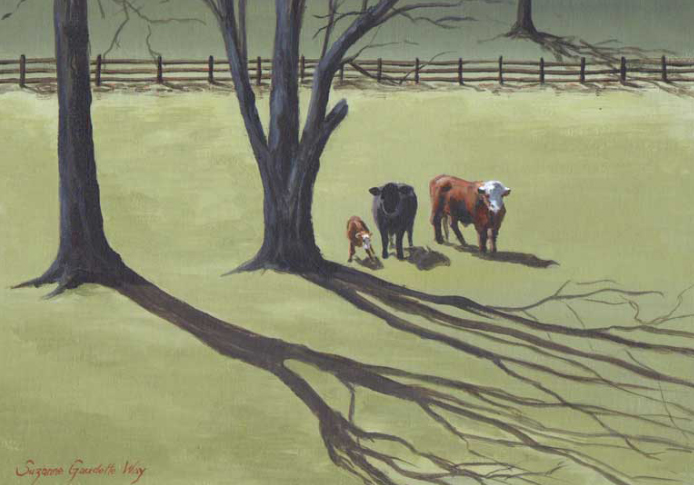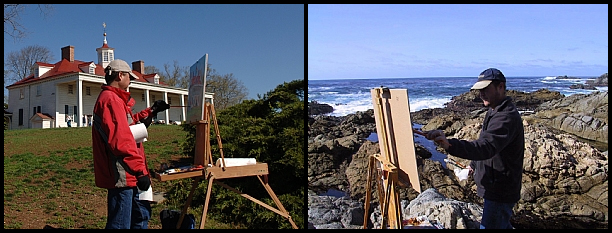Archived Comments
Enjoy the past comments below for Maker’s blinders…
There are any number of “tricks” to see the flaws in a work-in-progress. The simplest is to turn the painting upside down, go have a cup of coffee, and look at it when you come back, from across the room. Often drawing and compositional flaws will jump out at you when you do that. If you have trouble with values, look at it through a red filter to mute the colors or scan it into your computer and reduce the color saturation that way (in the olden days, I would use a copy machine, if the painting was small enough). Once the image is in your computer, you can look at it at a reduced size, flip it horizontally or vertically, “unfocus” the picture (or just take off your glasses), or manipulate it in different ways to try to see the problem areas or how it could be improved. Another way is to work on several paintings at once, so you can leave one and work on the others for a week. Come back after a time and look at the first one, and you may see problems that you missed while you were painting it. Or you may see that it’s pretty good after all!
I have been working on a painting of a barn for a couple of weeks now and something about it has really been bothering me. I painted and re-painted. Finally I took it to one of my classes and let my students pick it apart and they had some ideas. it wasn’t until I took it back home that I finally saw a glaring error. I should have photoed it. I had a roofline ending at the edge of the painting right next to the edge of a major area of bushes. Your eye was directed right out of the painting. I was able to correct it but it is strange that all that time I was working on this now very irritating painting I would have discovered such an obvious problem. I think it was moving it to a different location, in different light and having new eyes look at it. This enabled me to also look at it with a fresh eye, I think.
I have been teaching painting for a number of years and one simple trick that all my students routinely ignore ( at least until I remind them ) is the act of stepping back. All you need to do is walk away from your painting several feet turn around and look. This simple yet effective tool will keep you looking at the entire composition all the way through the process. This has become so ingrained into my painting process that I often put only a couple of strokes of paint on the canvas step back, paint a few strokes more, step back and so on. The second important habit is to be painting all of the composition all of the time. It is important not to become too focused on one area when other areas are not even worked on yet. This gives you a true overview of the level of colour saturation and if it is working or not.
Yes, stepping back frequently and squinting is most important. Another tactic is to turn your back to it, and look at it in a mirror. I also employ the “time” element …working on 2-3 dozen at a time, setting them aside in various stages, not in a hurry to get them completed.
I left my job to pursue my passion of art. You are such a gift to the art world. We are so blessed to have you. www.natalias-gallery.net
Many artists have the same problem. When I get stuck on a certain aspect of my work I get away for while or put it in the distance to review and rethink what my intention for painting it in the first place. I ask my self what is the inspiration behind the work and how do I make it clear. Review part by part perhaps dividing it in sections to connect each part to make the whole. Do they coincide or do they complement or are they unified as one to tell the whole message. When I do this looking the work as a whole I can see where I need to work on.
I love Robert Genn – LOVE his whole sensibility, approach to things, positive take on everything.
My work is also a spiritual walk. It’s about taking all those things that make me who I am,things seen,places traveled and translating them to the canvas. thanks for in site.
I have been painting for over forty years, most of it pure delight. I have recently discovered one way to see the big picture without getting too analytical about progress is to cover my work with a sheet when I finish each day. I don’t allow myself to look at it until I begin the next session. When I uncover it I can immediately see what needs attention and how to work the next stage. For me this has been a revelation enabling me to stay focused and consistent. I must say that I usually work over the whole canvas so that elements remain balanced. If I am working outdoors I paint on the bonnet of my station wagon – covered of course – and a large, complete painting takes approx. two to three hours working the entire surface almost like a dance rhythm. My other big decision this year has been to not allow anyone to view my work until it is complete. I find that the comments of others tend to poison my thinking and bring me into performance mode rather than creative. This too has proved a big success, in fact I am not allowing anyone to see my present series until I have pretty near completed it – who knows how long that will take?
You might also suggest that the artist simply re-acquaint herself with the principle of movement, specifically visual movement. There’s a time and place for “deer in the headlights” emphasis, (or as I sometimes refer to it, “punch you in the face with art”) but the artist is not really thinking of the viewer too much if she is creating her art in such a way. It’s an interesting reflection on self absorption actually. The artist focuses on a part that she is good at, and only wants the viewer to look at that part as well. The other areas become excessively subordinate and neglected. It’s like art that is always on it’s best behavior and never flawed. But with visual movement, those other areas are just as important. Yes, they may not be as dazzling, but they help to create a beautiful flow throughout an art piece so that we see the whole person, er, I mean, the whole art piece. I would suggest an exploration of that principle, both in her art and her life. Working beyond the confines of her specialty and delving into new perspectives and considerations may actually have a gestalt effect, where the total is larger than the sum of its parts.
I find this to be a common problem. One solution I use is to develop the painting as a whole. I work my piece in three stages 1- The Lay in. I draw in thin paint until the idea and items are placed relatively correct. I stay here as long as it takes. In fact each stage takes as long as it takes. 2- Rendering. I work the whole canvas bringing everything along together. Again, this takes as long as it takes. 3- Finish. By the time I reach this stage, everything is developed to my satisfaction and areas well. From here I add the “flourishes” to give a painterly effect. I dot my “I’s” and cross my “t’s”. Using this method keeps one from noodling in one area too long. The two last pieces of advice. 1- Don’t critique your on-going work. Wait until you finish. 2- Don’t fall in love with a piece while you work it. Again, wait until you finish.
I have recently discovered that when I take a photo of a tapestry, and post it on my blog, I instantly see everything that is wrong with it! When this happens soon enough I can unweave (“penelope”) and make corrections. The camera “sees” things that my eyes miss.
Getting blinkered is a significant male artist problem. At some time a sort of arrested development kicks in, and the male artist caves into it. Economics and the need to be right as well as provide for a family may be part of it, but that cant be the whole problem, because many women have it pretty bad.
We need to broaden ourselves as whole people before we can unblinker ourselves as artists. Art is a life, not a series of techniques that work.
Many painters are blinkered in their use of colour. Without an understanding of the values of grays and neutralization that makes bright colors stand out, there is no craft. Some galleries are full of garish work that shows this fault to be so widespread it has become acceptable.
Hello Robert..While in Taos…..visit me at the E.L. Blumenschein Museum…You will enjoy the museum…
Some of the early Hippies. Looks like they were enjoying themselves.
Keep your eyes and your mind open, and both sides of your brain will contribute appropriately.


Family acrylic painting, 11 x 14 inches by Suzanne Gaudette Way, Nashville, TN, USA |













What a wonderful, serene painting! I’d like to walk into it and climb those hills.